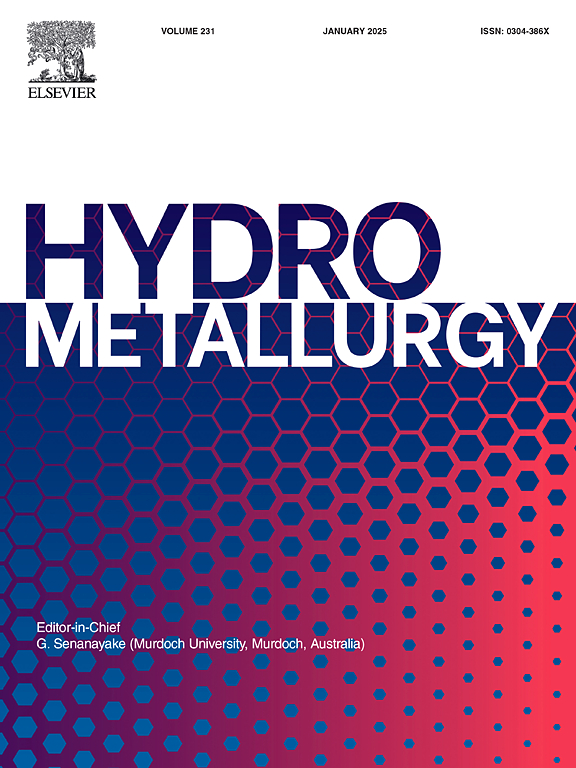在伊朗 Sarcheshmeh 铜矿联合企业的溶剂萃取装置中使用强力吸水试剂从渣滓中高效回收有机相
IF 4.8
2区 材料科学
Q1 METALLURGY & METALLURGICAL ENGINEERING
引用次数: 0
摘要
在几乎所有商用溶剂萃取(SX)设备中,形成稳定的多相乳浊液(淤泥)都是一个严重的问题。淤泥是有机相、水相、空气、有机或无机固体颗粒的混合物,经常在 SX 工厂的分离相中随机分布。几乎所有金属萃取厂的 SX 设备都会产生沉渣。它会造成溶剂损失,从而增加工艺成本。因此,清除沉渣并回收昂贵的有机相(包括稀释剂)以及从中提取试剂就显得尤为重要。在这项研究中,研究了一系列强力吸水试剂的适用性,以从 Sarchashmeh 铜联合企业(伊朗)铜萃取/电解装置中形成的污泥中回收有机相。试剂包括石膏、卡波姆、聚丙烯酸钠、硫酸钠、硫酸镁和氯化钙。结果表明,石膏、卡波姆和聚丙烯酸钠是有效的添加剂,可使有机相的回收率高达 95%。为了确保石膏不会对回收溶剂的铜负载和剥离造成负面影响,我们将使用石膏分离的有机相的萃取/剥离特性与不使用添加剂的离心分离有机相的萃取/剥离特性进行了比较。对石膏回收的有机相进行的表面张力分析也证实了其适用于从污泥中回收有机相。最后,测量了石膏回收有机相的钙含量,并将其与不加任何添加剂的离心分离有机相的钙含量进行了比较。本文章由计算机程序翻译,如有差异,请以英文原文为准。
Efficient recovery of organic phase from crud in solvent extraction unit of Sarcheshmeh copper complex in Iran by powerful water-absorbent reagents
The formation of stable multi-phase emulsions (crud) is a serious problem in almost all commercial solvent extraction (SX) plants. Crud is a mixture of organic and aqueous phases, air, and organic or inorganic solid particles, often found to distribute itself randomly throughout the separating phases of SX plants. Crud formation is encountered in almost all SX units in metal extraction plants. It causes the loss of solvent and thus increases the process costs. Therefore, the removal of crud and recovery of the expensive organic phase including diluent and extracting reagents from it is of great importance. In this research, the applicability of a range of powerful water absorbent reagents was studied for the recovery of organic phase from the crud formed in copper extraction/electrowining unit of Sarchashmeh copper complex (IRAN). The reagents included gypsum, carbomer, sodium polyacrylate, sodium sulfate, magnesium sulfate and calcium chloride. The results showed that gypsum, carbomer and sodium polyacrylate are effective additives which let the organic phase to be recovered with up to 95 % yield. To ensure that gypsum does not cause a negative effect on the copper loading and stripping of the recovered solvent, the extraction/stripping properties of the organic phase separated with gypsum was compared with the organic phase separated by centrifugation without additives. Surface tension analysis of the gypsum-recovered organic phase also confirmed its suitability for recovery of organic phase from crud. Finally, the calcium content of gypsum-recovered organic phase was measured and compared with that of the organic phase separated by centrifugation without any additive.
求助全文
通过发布文献求助,成功后即可免费获取论文全文。
去求助
来源期刊

Hydrometallurgy
工程技术-冶金工程
CiteScore
9.50
自引率
6.40%
发文量
144
审稿时长
3.4 months
期刊介绍:
Hydrometallurgy aims to compile studies on novel processes, process design, chemistry, modelling, control, economics and interfaces between unit operations, and to provide a forum for discussions on case histories and operational difficulties.
Topics covered include: leaching of metal values by chemical reagents or bacterial action at ambient or elevated pressures and temperatures; separation of solids from leach liquors; removal of impurities and recovery of metal values by precipitation, ion exchange, solvent extraction, gaseous reduction, cementation, electro-winning and electro-refining; pre-treatment of ores by roasting or chemical treatments such as halogenation or reduction; recycling of reagents and treatment of effluents.
 求助内容:
求助内容: 应助结果提醒方式:
应助结果提醒方式:


